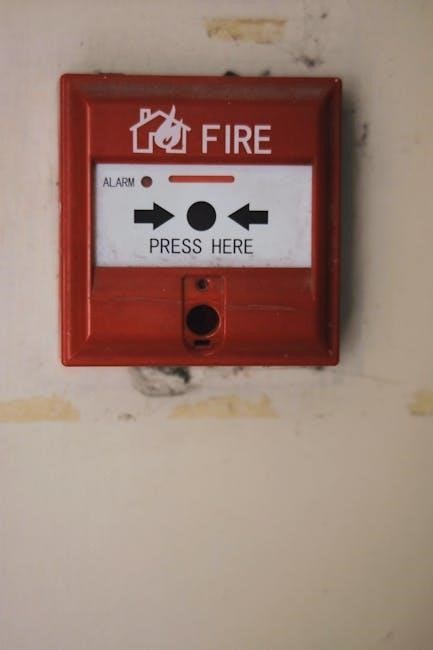A fire alarm manual station is a critical component in fire safety systems, enabling individuals to trigger alarms during emergencies. These stations are essential for initiating rapid responses, ensuring timely evacuation and minimizing potential damage. Their presence is vital in public spaces, workplaces, and residential areas to enhance safety protocols effectively.
Definition and Purpose
A fire alarm manual station is a device that enables individuals to manually trigger a fire alarm, alerting others to potential dangers. Its primary purpose is to provide a reliable means of initiating emergency responses, ensuring timely evacuations, and preventing incidents from escalating. The absence of such systems, as seen in the German fire station incident, highlights their critical role in fire safety and emergency preparedness.
Importance in Fire Safety Systems
Manual fire alarm stations are crucial in fire safety systems as they enable immediate alerts during emergencies, ensuring timely responses. A recent incident in Germany, where a new fire station lacking an alarm system suffered millions in damages, highlights their necessity. These stations provide a reliable way to initiate evacuation procedures, preventing extensive loss and ensuring safety effectively.

Components of a Fire Alarm Manual Station
A manual station typically includes a pull lever, reset key, status indicator, and electrical contacts. These components work together to activate alarms and ensure system functionality during emergencies.
Mechanical Components
The mechanical components of a fire alarm manual station include a durable lever or handle, a resettable mechanism, and a sturdy housing. These parts ensure the station can withstand regular use and operate reliably during emergencies. The lever or handle is designed for easy activation, while the reset mechanism allows the system to be turned off after an alarm. These components are vital for initiating alerts promptly, as seen in cases where their absence led to significant damage, such as the fire station incident in Germany.
Electrical and Electronic Components
The electrical and electronic components of a fire alarm manual station include sensors, circuits, and microcontrollers that detect and process signals. These components ensure reliable activation of alarms when the station is triggered. Advanced systems may incorporate communication interfaces like RS485 or Wi-Fi for integration with central monitoring systems. Power sources, including batteries, are critical for uninterrupted operation during emergencies. Modern designs often feature advanced signal processing and LED indicators for status verification, ensuring rapid response capabilities and compliance with safety standards. The absence of such systems, as seen in the Stadtallendorf fire station incident, highlights their importance in preventing catastrophic outcomes.
Types of Fire Alarm Manual Stations
Manual stations are categorized into standard and intelligent types. Standard stations are basic pull devices, while intelligent stations offer advanced features like addressability for precise alarm location identification.
Standard Manual Pull Stations
Standard manual pull stations are simple, durable devices designed to activate fire alarms when pulled. They are typically wall-mounted, easily visible, and placed in accessible locations. These stations operate mechanically, requiring a physical pull to trigger the alarm. Their straightforward design ensures reliability in emergencies, making them a fundamental component of fire safety systems. Their presence is crucial for rapid response initiation, as seen in incidents where their absence led to significant damage, such as the fire station in Germany that lacked an alarm system, resulting in millions of euros in losses. These stations emphasize the importance of immediate human intervention in fire emergencies, ensuring timely evacuation and minimizing potential hazards. Their effectiveness lies in their simplicity and accessibility, making them indispensable in public and commercial spaces. Regular testing and maintenance are essential to ensure their functionality, as they are often the first line of defense in fire incidents. By providing a direct means to alert others, standard manual pull stations play a vital role in safeguarding lives and property. Their widespread use underscores their reliability and necessity in modern fire safety protocols. In summary, these stations are a critical and cost-effective solution for initiating emergency responses, highlighting their importance in fire safety strategies worldwide. Their role in preventing catastrophic outcomes cannot be overstated, as evidenced by their inclusion in fire codes and safety regulations globally.
Intelligent Manual Pull Stations
Intelligent manual pull stations are advanced fire alarm devices that combine traditional functionality with modern technology. They offer digital reporting, real-time monitoring, and integration with building management systems. These stations enhance reliability by providing detailed incident data, enabling faster response times and improved emergency management. Their intelligent features ensure seamless communication with other fire safety components, making them indispensable in modern fire safety systems.

Installation Requirements
Manual stations must be installed in visible, accessible locations such as exits and corridors, ensuring compliance with local fire codes and standards for effective emergency response.
Location and Placement Guidelines
Fire alarm manual stations must be strategically placed in accessible, visible locations to ensure quick activation during emergencies. They should be installed along escape routes, near exits, and in high-traffic areas. Stations must be positioned between 42 and 54 inches above the floor for easy access. Clear visibility and unobstructed access are critical to prevent delays. Proper placement ensures compliance with fire safety standards and enhances emergency response efficiency.
Compliance with Fire Safety Codes
Fire alarm manual stations must adhere to local and national fire safety codes, such as NFPA 72, to ensure reliability and effectiveness. Compliance involves proper installation, testing, and maintenance procedures, as outlined by regulatory standards. Failure to meet these codes can result in legal penalties and increased risks during emergencies, emphasizing the importance of strict adherence to safety protocols.
Testing and Maintenance
Regular testing of manual stations ensures functionality, while scheduled maintenance prevents malfunctions. Inspections and repairs are crucial to uphold reliability and compliance with safety standards effectively.
Regular Testing Procedures
Regular testing of fire alarm manual stations ensures reliability and functionality. Visual inspections should be conducted monthly to check for damage or tampering. Functional tests involve activating the station to verify it sends signals to the central system. Communication with other fire safety devices should also be tested. These procedures, performed by authorized personnel, help maintain system integrity and ensure timely emergency responses, preventing incidents like the Stadtallendorf fire station incident.
Maintenance and Inspection Frequency
Manual fire alarm stations require regular inspections to ensure functionality. Monthly visual checks and annual professional inspections are recommended. Testing involves activating the station to confirm proper alarm signaling. Maintenance should address worn or damaged components promptly; Adherence to local fire codes and manufacturer guidelines ensures reliability and compliance, preventing system failures during emergencies.

Role in Fire Safety Systems
Manual stations serve as a critical trigger point for fire safety systems, enabling quick activation of alarms to ensure early detection and prompt emergency responses.
Integration with Other Fire Safety Devices
Manual stations seamlessly integrate with smoke detectors, sprinklers, and central monitoring systems, ensuring a coordinated response during emergencies. This interconnectedness enhances overall fire safety by enabling simultaneous activation of alarms and suppression systems. The incident in Germany, where a fire station lacked an alarm system, underscores the importance of such integration to prevent devastating outcomes and ensure prompt emergency responses.
Response Time and Efficiency
Manual fire alarm stations play a critical role in ensuring rapid response during emergencies. Their quick activation minimizes delay in alerting occupants and emergency services, which is vital for preventing escalation of fires. The absence of such systems, as seen in the Stadtallendorf fire station incident, underscores the importance of reliable manual activation to ensure timely alerts and minimize potential damage effectively;
Advantages of Manual Fire Alarm Stations
Manual fire alarm stations offer reliability, immediate response, and cost-effectiveness, ensuring quick activation during emergencies without relying on automated systems, proven crucial as seen in recent fire incidents.
Reliability in Emergency Situations
Fire alarm manual stations are dependable in emergencies, providing a direct means to activate alerts when automated systems fail. Their simple, durable design ensures functionality under stress, offering a critical failsafe. The incident in Stadtallendorf, Germany, where a fire station without an alarm system suffered severe damage, underscores their importance in promptly initiating responses and preventing escalation.
Cost-Effectiveness
Manual fire alarm stations are a cost-effective solution for enhancing fire safety. They require minimal installation and maintenance costs compared to automated systems. Their simplicity ensures long-term savings, making them a practical choice for businesses and institutions seeking reliable emergency response systems without excessive financial burden. This affordability contributes to their widespread adoption in various settings.
Challenges and Limitations
Potential for False Alarms
Manual stations can be accidentally activated, leading to false alarms, which disrupt operations and reduce trust in the system over time, requiring careful management.
False alarms from manual stations can occur due to accidental activation or tampering, leading to unnecessary disruptions and emergency responses. This underscores the importance of proper installation, maintenance, and user education to minimize such incidents. Additionally, integrating smart technology can help differentiate between genuine emergencies and false triggers, enhancing system reliability and public trust in fire safety systems.
Dependence on Human Intervention
Manual fire alarm stations rely on individuals to activate them during emergencies, which can lead to delays if not promptly addressed. Human error or oversight may result in late notifications, potentially worsening situations. The case of a fire station without an alarm system underscores the importance of reliable activation, highlighting vulnerabilities in systems dependent on human intervention for timely alerts and responses.
Case Study: Fire Station Without Fire Alarm System
A newly built fire station in central Germany was destroyed by fire, causing millions in damages; It lacked a fire alarm system, highlighting critical safety oversights.
Incident Overview
A newly constructed fire station in central Germany suffered a devastating fire, causing millions of euros in damage and destroying equipment; Ironically, the facility lacked a fire alarm system, highlighting a critical oversight in safety measures. The blaze erupted in an area believed to be the garage, spreading rapidly due to delayed detection. This incident underscores the importance of robust fire safety systems, even in facilities designed for emergency response.
Lessons Learned
The incident highlights the critical importance of installing fire alarm systems, even in fire stations. The absence of an alarm delayed response, exacerbating damage. This underscores the necessity of manual stations for early detection and rapid action. Compliance with fire safety codes and regular maintenance are essential to prevent such disasters, ensuring preparedness and saving lives and property.
Compliance and Regulations
Fire alarm manual stations must comply with local and national fire codes, such as NFPA 72, ensuring proper installation, testing, and maintenance to guarantee reliability and safety standards.
Local and National Fire Codes
Local and national fire codes mandate the installation and maintenance of fire alarm manual stations, ensuring compliance with safety standards. These codes outline specific requirements for placement, visibility, and accessibility to guarantee effective emergency response. Non-compliance can result in legal penalties and increased fire risks, as seen in incidents like the German fire station without an alarm system.
International Standards
Fire alarm manual stations must comply with international standards like ISO 7240-7 and NFPA 72, ensuring reliability and compatibility across global fire safety systems. These standards regulate design, installation, and maintenance, guaranteeing devices meet safety and performance criteria. Compliance ensures seamless integration with modern fire safety technologies, enhancing overall system efficiency and effectiveness in emergency scenarios worldwide.

Integration with Modern Fire Alarm Systems
Manual stations seamlessly integrate with modern fire alarm systems, enhancing connectivity and monitoring capabilities. This integration improves response times and ensures comprehensive fire safety coverage.
Smart Technology and Connectivity
Modern fire alarm manual stations integrate smart technology, enabling real-time monitoring and connectivity to central systems. IoT capabilities allow remote access, data analysis, and faster response times. This connectivity ensures seamless communication between manual stations and monitoring centers, enhancing fire safety. The case of a German fire station without an alarm system highlights the importance of such integrated solutions in preventing tragedies.
Central Monitoring Systems
Central monitoring systems play a crucial role in fire safety by providing real-time oversight of fire alarm manual stations. These systems collect data, send immediate alerts, and help coordinate responses during emergencies. Integration with manual stations ensures prompt action, reducing potential damage. The recent incident in Germany underscores the importance of such systems in preventing catastrophic outcomes, highlighting their necessity in modern fire safety infrastructure.
Training and User Education
Proper training ensures users understand how to activate manual stations and follow emergency protocols. Regular drills and education reduce false alarms and improve response effectiveness in critical situations.
Proper Use of Manual Stations
Manual fire alarm stations must be activated only in genuine emergencies to avoid false alarms. Individuals should pull the lever or break the glass firmly to trigger the alarm. Proper training ensures users understand the station’s operation and the consequences of misuse. Regular testing and inspection are crucial to maintain functionality and reliability, ensuring swift responses during actual emergencies.
Emergency Response Protocols
Effective emergency response protocols ensure timely action upon activating a fire alarm manual station. Training programs emphasize proper evacuation routes, communication strategies, and coordination with emergency services. Quick response minimizes risks and prevents escalation. Protocols also include procedures for investigating false alarms to maintain system reliability and public trust. Regular drills reinforce these practices, ensuring preparedness in critical situations.

Future Trends
Future trends include smart technology integration, IoT connectivity, and predictive analytics for enhanced fire safety. Manual stations will likely adopt AI for early fire detection and improved response systems.
Advancements in Technology
Modern fire alarm manual stations now integrate smart technology, offering enhanced functionality and connectivity. Addressable systems enable precise location identification of activations, improving response efficiency. Advanced sensors with multi-criteria detection reduce false alarms, while IoT connectivity allows real-time monitoring and faster emergency responses. These innovations ensure greater reliability and integration with central monitoring systems, revolutionizing fire safety protocols and emergency management.
Enhanced Safety Features
Modern fire alarm manual stations integrate advanced technologies, such as tamper-proof mechanisms and real-time monitoring, to ensure reliable activation during emergencies. These features prevent accidental triggering and provide immediate alerts, enhancing response times. The incident in Germany, where a fire station lacked an alarm system, underscores the importance of such advancements in safeguarding lives and property effectively.

Best Practices for Manual Station Usage
Regularly test manual stations, ensure proper training, and avoid false alarms. Post clear instructions and maintain accessibility to prevent delays during emergencies, ensuring effective response.
Preventive Measures
Regular inspections and testing of manual stations ensure functionality. Proper placement in accessible locations maximizes visibility and use. Training individuals on correct operation reduces false alarms. Ensuring stations are free from obstructions and tampering prevents malfunctions. Routine maintenance, including cleaning and battery checks, guarantees reliability. These measures enhance system efficiency and contribute to overall fire safety preparedness in buildings and public spaces effectively.
Emergency Preparedness
Emergency preparedness involves regular drills, training, and inspections of fire alarm manual stations to ensure quick and effective responses during crises. Proper education on their use prevents false alarms and ensures systems function reliably. This proactive approach enhances safety, minimizing risks and potential damage, as seen in incidents like the Stadtallendorf fire station incident, where lack of preparedness led to significant consequences.
Fire alarm manual stations are indispensable in ensuring timely emergency responses, highlighting the importance of reliable systems and human intervention to safeguard lives and property effectively.
Fire alarm manual stations are essential for initiating emergency responses, ensuring timely evacuations and minimizing damage. They consist of mechanical and electrical components, with types ranging from standard to intelligent systems. Proper installation, regular testing, and maintenance are critical for reliability. While they offer cost-effectiveness and efficiency, challenges like false alarms and human dependency exist. Their integration with modern systems underscores their vital role in fire safety, as highlighted by incidents like the German fire station case.
Final Thoughts on Fire Safety
Fire alarm manual stations are indispensable in ensuring swift responses to emergencies, safeguarding lives and property. The absence of such systems, as seen in the German fire station incident, underscores their critical role. Balancing technology with human responsibility is essential for effective fire safety. Compliance with codes and regular maintenance are vital to prevent tragedies. Preparedness saves lives.